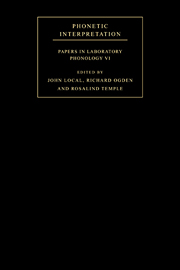Book contents
- Frontmatter
- Contents
- List of contributors
- Acknowledgements
- Introduction
- Part I Phonological representations and the lexicon
- 1 Interpreting ‘phonetic interpretation’ over the lexicon
- 2 Effects on word recognition of syllable-onset cues to syllable-coda voicing
- 3 Speech perception, well-formedness and the statistics of the lexicon
- 4 Factors of lexical competition in vowel articulation
- 5 Commentary: probability, detail and experience
- Part II Phonetic interpretation and phrasal structure
- Part III Phonetic interpretation and syllable structure
- Part IV Phonology and natural speech production: tasks, contrasts and explanations
- References
- Index of names
- Index of subjects
3 - Speech perception, well-formedness and the statistics of the lexicon
Published online by Cambridge University Press: 22 September 2009
- Frontmatter
- Contents
- List of contributors
- Acknowledgements
- Introduction
- Part I Phonological representations and the lexicon
- 1 Interpreting ‘phonetic interpretation’ over the lexicon
- 2 Effects on word recognition of syllable-onset cues to syllable-coda voicing
- 3 Speech perception, well-formedness and the statistics of the lexicon
- 4 Factors of lexical competition in vowel articulation
- 5 Commentary: probability, detail and experience
- Part II Phonetic interpretation and phrasal structure
- Part III Phonetic interpretation and syllable structure
- Part IV Phonology and natural speech production: tasks, contrasts and explanations
- References
- Index of names
- Index of subjects
Summary
Introduction
The speech literature abounds in evidence that language-specific phonotactic patterns affect perception. Phonotactics affect placement of phoneme category boundaries (Massaro and Cohen 1983), segmentation of nonce forms (Suomi, McQueen and Cutler 1997), and speed and accuracy of phoneme monitoring (Otake, Yoneyama, Cutler and van der Lugt 1996). Papers in previous volumes in this series (Pierrehumbert 1994; Treiman, Kessler, Knewasser and Tincoff 2000) have provided evidence that perceived well-formedness of phoneme combinations is related to their frequency in the language. Coleman (1996) also found that speakers rated neologisms with attested clusters higher than those containing unattested clusters.
These results indicate that speakers generalise over the entries in their lexicons, and respond differently to patterns which are exemplified versus ones which are not. However, patterns may be exemplified to different degrees. This raises the question of whether knowledge of phonotactics is categorical, distinguishing only possible from impossible forms (as predicted by classical generative models), or whether it is gradient, tracking lexical statistics more finely. Some evidence is available from studies which report different outcomes for high- and low-frequency configurations.
Jusczyk, Luce and Charles-Luce (1994) found that 9-month-old infants prefer frequent phonotactic patterns in their language to infrequent ones. Saffran, Aslin and Newport (1996a) showed that 8-month-old infants are sensitive to transitional probabilities in nonsense speech streams. Saffran, Newport and Aslin (1996b) show similar sensitivity in adults.
- Type
- Chapter
- Information
- Phonetic InterpretationPapers in Laboratory Phonology VI, pp. 58 - 74Publisher: Cambridge University PressPrint publication year: 2004
- 2
- Cited by



